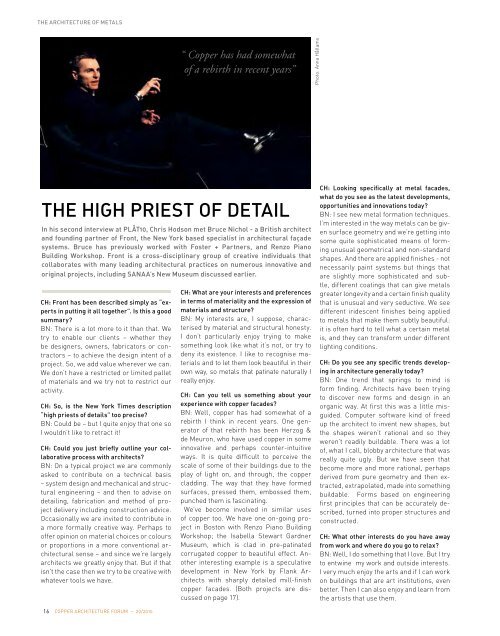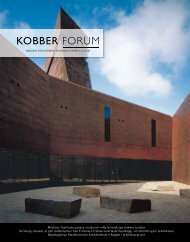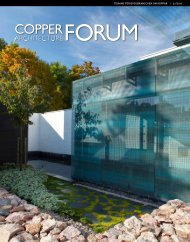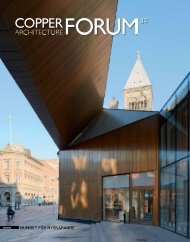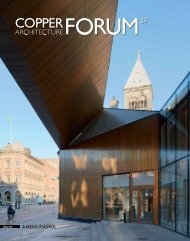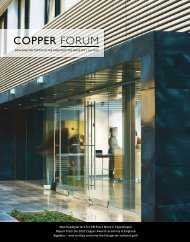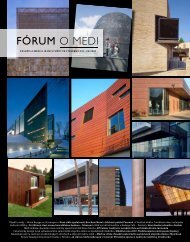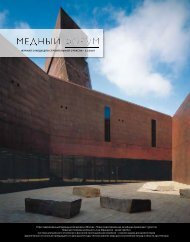renovation of the clock tower at Helsinki railway station - Copper ...
renovation of the clock tower at Helsinki railway station - Copper ...
renovation of the clock tower at Helsinki railway station - Copper ...
Create successful ePaper yourself
Turn your PDF publications into a flip-book with our unique Google optimized e-Paper software.
THE ARCHITECTURE OF METALS<br />
CH: Front has been described simply as “experts<br />
in putting it all toge<strong>the</strong>r”. Is this a good<br />
summary?<br />
BN: There is a lot more to it than th<strong>at</strong>. We<br />
try to enable our clients – whe<strong>the</strong>r <strong>the</strong>y<br />
be designers, owners, fabric<strong>at</strong>ors or contractors<br />
– to achieve <strong>the</strong> design intent <strong>of</strong> a<br />
project. So, we add value wherever we can.<br />
We don’t have a restricted or limited pallet<br />
<strong>of</strong> m<strong>at</strong>erials and we try not to restrict our<br />
activity.<br />
CH: So, is <strong>the</strong> New York Times description<br />
“high priests <strong>of</strong> details” too precise?<br />
BN: Could be – but I quite enjoy th<strong>at</strong> one so<br />
I wouldn’t like to retract it!<br />
CH: Could you just briefly outline your collabor<strong>at</strong>ive<br />
process with architects?<br />
BN: On a typical project we are commonly<br />
asked to contribute on a technical basis<br />
– system design and mechanical and structural<br />
engineering – and <strong>the</strong>n to advise on<br />
detailing, fabric<strong>at</strong>ion and method <strong>of</strong> project<br />
delivery including construction advice.<br />
Occasionally we are invited to contribute in<br />
a more formally cre<strong>at</strong>ive way. Perhaps to<br />
<strong>of</strong>fer opinion on m<strong>at</strong>erial choices or colours<br />
or proportions in a more conventional architectural<br />
sense – and since we’re largely<br />
architects we gre<strong>at</strong>ly enjoy th<strong>at</strong>. But if th<strong>at</strong><br />
isn’t <strong>the</strong> case <strong>the</strong>n we try to be cre<strong>at</strong>ive with<br />
wh<strong>at</strong>ever tools we have.<br />
16<br />
COPPER ARCHITECTURE FORUM – 29/2010<br />
“ <strong>Copper</strong> has had somewh<strong>at</strong><br />
<strong>of</strong> a rebirth in recent years”<br />
THE HIGH PRIEST OF DETAIL<br />
In his second interview <strong>at</strong> PLÅT10, Chris Hodson met Bruce Nichol - a British architect<br />
and founding partner <strong>of</strong> Front, <strong>the</strong> New York based specialist in architectural façade<br />
systems. Bruce has previously worked with Foster + Partners, and Renzo Piano<br />
Building Workshop. Front is a cross-disciplinary group <strong>of</strong> cre<strong>at</strong>ive individuals th<strong>at</strong><br />
collabor<strong>at</strong>es with many leading architectural practices on numerous innov<strong>at</strong>ive and<br />
original projects, including SANAA’s New Museum discussed earlier.<br />
CH: Wh<strong>at</strong> are your interests and preferences<br />
in terms <strong>of</strong> m<strong>at</strong>eriality and <strong>the</strong> expression <strong>of</strong><br />
m<strong>at</strong>erials and structure?<br />
BN: My interests are, I suppose, characterised<br />
by m<strong>at</strong>erial and structural honesty.<br />
I don’t particularly enjoy trying to make<br />
something look like wh<strong>at</strong> it’s not, or try to<br />
deny its existence. I like to recognise m<strong>at</strong>erials<br />
and to let <strong>the</strong>m look beautiful in <strong>the</strong>ir<br />
own way, so metals th<strong>at</strong> p<strong>at</strong>in<strong>at</strong>e n<strong>at</strong>urally I<br />
really enjoy.<br />
CH: Can you tell us something about your<br />
experience with copper facades?<br />
BN: Well, copper has had somewh<strong>at</strong> <strong>of</strong> a<br />
rebirth I think in recent years. One gener<strong>at</strong>or<br />
<strong>of</strong> th<strong>at</strong> rebirth has been Herzog &<br />
de Meuron, who have used copper in some<br />
innov<strong>at</strong>ive and perhaps counter-intuitive<br />
ways. It is quite difficult to perceive <strong>the</strong><br />
scale <strong>of</strong> some <strong>of</strong> <strong>the</strong>ir buildings due to <strong>the</strong><br />
play <strong>of</strong> light on, and through, <strong>the</strong> copper<br />
cladding. The way th<strong>at</strong> <strong>the</strong>y have formed<br />
surfaces, pressed <strong>the</strong>m, embossed <strong>the</strong>m,<br />
punched <strong>the</strong>m is fascin<strong>at</strong>ing.<br />
We’ve become involved in similar uses<br />
<strong>of</strong> copper too. We have one on-going project<br />
in Boston with Renzo Piano Building<br />
Workshop; <strong>the</strong> Isabella Stewart Gardner<br />
Museum, which is clad in pre-p<strong>at</strong>in<strong>at</strong>ed<br />
corrug<strong>at</strong>ed copper to beautiful effect. Ano<strong>the</strong>r<br />
interesting example is a specul<strong>at</strong>ive<br />
development in New York by Flank Architects<br />
with sharply detailed mill-finish<br />
copper facades. (Both projects are discussed<br />
on page 17).<br />
Photo: Anna Hållams<br />
CH: Looking specifically <strong>at</strong> metal facades,<br />
wh<strong>at</strong> do you see as <strong>the</strong> l<strong>at</strong>est developments,<br />
opportunities and innov<strong>at</strong>ions today?<br />
BN: I see new metal form<strong>at</strong>ion techniques.<br />
I’m interested in <strong>the</strong> way metals can be given<br />
surface geometry and we’re getting into<br />
some quite sophistic<strong>at</strong>ed means <strong>of</strong> forming<br />
unusual geometrical and non-standard<br />
shapes. And <strong>the</strong>re are applied finishes - not<br />
necessarily paint systems but things th<strong>at</strong><br />
are slightly more sophistic<strong>at</strong>ed and subtle,<br />
different co<strong>at</strong>ings th<strong>at</strong> can give metals<br />
gre<strong>at</strong>er longevity and a certain finish quality<br />
th<strong>at</strong> is unusual and very seductive. We see<br />
different iridescent finishes being applied<br />
to metals th<strong>at</strong> make <strong>the</strong>m subtly beautiful:<br />
it is <strong>of</strong>ten hard to tell wh<strong>at</strong> a certain metal<br />
is, and <strong>the</strong>y can transform under different<br />
lighting conditions.<br />
CH: Do you see any specific trends developing<br />
in architecture generally today?<br />
BN: One trend th<strong>at</strong> springs to mind is<br />
form finding. Architects have been trying<br />
to discover new forms and design in an<br />
organic way. At first this was a little misguided.<br />
Computer s<strong>of</strong>tware kind <strong>of</strong> freed<br />
up <strong>the</strong> architect to invent new shapes, but<br />
<strong>the</strong> shapes weren’t r<strong>at</strong>ional and so <strong>the</strong>y<br />
weren’t readily buildable. There was a lot<br />
<strong>of</strong>, wh<strong>at</strong> I call, blobby architecture th<strong>at</strong> was<br />
really quite ugly. But we have seen th<strong>at</strong><br />
become more and more r<strong>at</strong>ional, perhaps<br />
derived from pure geometry and <strong>the</strong>n extracted,<br />
extrapol<strong>at</strong>ed, made into something<br />
buildable. Forms based on engineering<br />
first principles th<strong>at</strong> can be accur<strong>at</strong>ely described,<br />
turned into proper structures and<br />
constructed.<br />
CH: Wh<strong>at</strong> o<strong>the</strong>r interests do you have away<br />
from work and where do you go to relax?<br />
BN: Well, I do something th<strong>at</strong> I love. But I try<br />
to entwine my work and outside interests.<br />
I very much enjoy <strong>the</strong> arts and if I can work<br />
on buildings th<strong>at</strong> are art institutions, even<br />
better. Then I can also enjoy and learn from<br />
<strong>the</strong> artists th<strong>at</strong> use <strong>the</strong>m.


